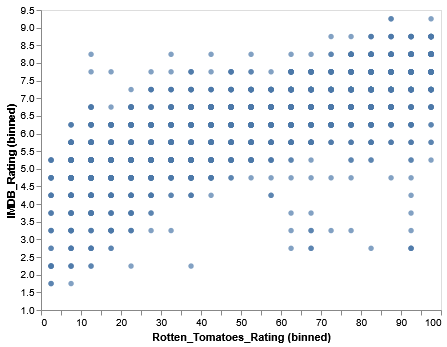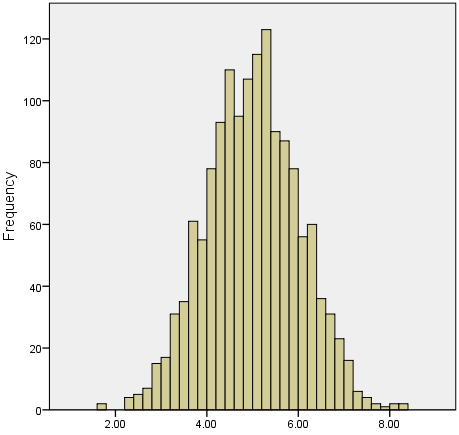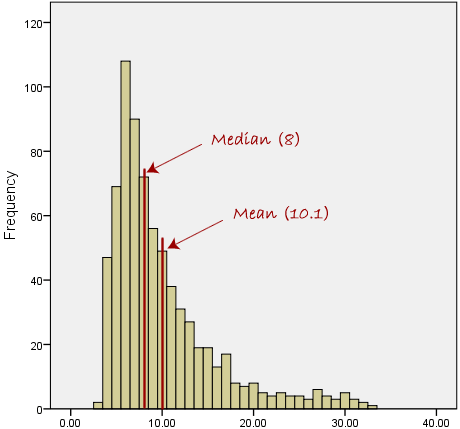Week 2 Lab: Intro to Vega-Lite DataTtransformations, Working with Real Datasets
CS-GY 6313 - Information Visualization
New York University
2025-09-12
Logistics
- TA Office Hours:
- Physical Location: Wednesdays @ 2PM-3PM, 8th floor common area @ 370 Jay Street, Brooklyn
- Online Zoom: (https://nyu.zoom.us/j/92815268504)
- Feedback:
- Difficulty of the assignment?
- Submission problems?
- Discord + Brightspace notifications?
Week 2 Lab Overview
| User Interface | Graphics Library | Notebook |
|---|---|---|
| observablehq.com | Vega-Lite | Week 2 Lab Notebook |
Today’s Lab Activities
All about data transformations with movies!
- Binning
- Aggregation
- Filtering
Normalization
Food 4 Thought: “Data” v.s. “Information”
A Question:
What’s the difference between data and information?
Food 4 Thought: “Data” v.s. “Information”
A Question:
What’s the difference between data and information?
Data v.s. Information
Data:
- Facts and statistics collected together for reference or analysis. Can be structured/unstructured, quantitative/qualitative, temporal/static.
- E.g. Census data, stock prices, sensor readings, survey responses, click streams.
- Alone, it lacks context and meaning.
Information:
- Processed and/or organized form of data.
- E.g. Sales reports, news articles, graphs & figures.
- Analyzed, structured, and given context through a narrative established by its handlers.
Meaning-Making: Data -> Information
As engineers, designers, and researchers, we must do the work to find meaning within the raw data and interpret them for the benefit of others.
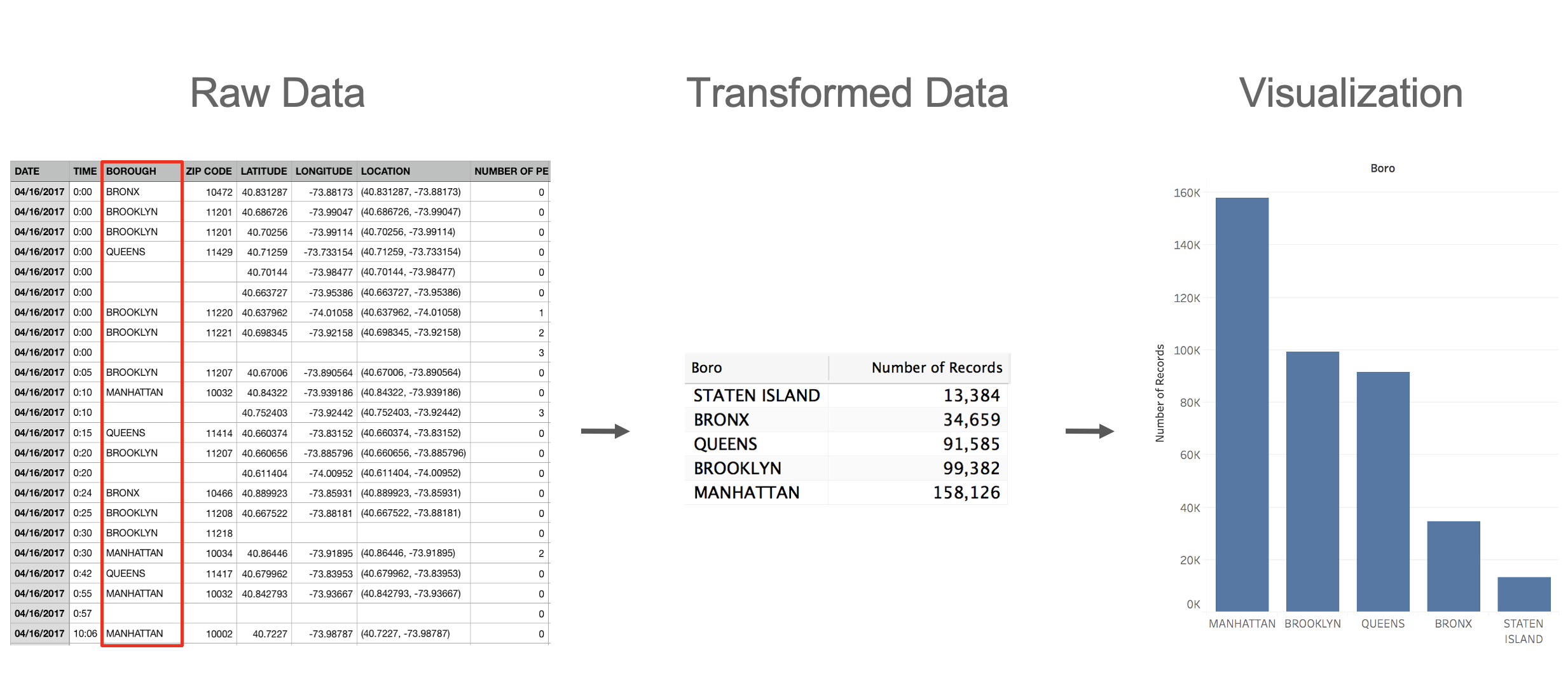
Dataset: Movies
Vega-Lite contains several datasets available to us. We’ll be using a dataset that describes movies.
Features/Columns:
TitleUS_GrossWorldwide_GrossUS_DVD_Sales
Production_BudgetRelease_DateMPAA_RatingRunning_Time_min
DistributorSourceMajor_GenreCreative_Type
DirectorRotten_Tomatoes_RatingIMDB_RatingIMDB_Votes
Review: 4 Major Data Transformations
Aggregation
- Purpose: Summarize groups of data
- Methods: Sum, mean, median, count, min, max
- Example: Daily sales → Monthly totals
Filtering
- Purpose: Focus on relevant subset
- Types: Range, categorical, conditional
Binning
- Purpose: Convert continuous to discrete
- Methods: Equal width, equal frequency, custom _ Example: Dividing age into groups (<18, 18-65, >65)
Normalization
- Purpose: Enable fair comparison
- Methods: Min-max, z-score, percentage
Step 1: Binning
- Grouping continuous data into discrete groups.
- What are some common examples?
- Age groups
- NYC Boroughs
- Years
- Grades/Scores
- Any kind of continuous data can be binned, in theory.
- We lose a bit of data in the meantime, but by doing so we increase the probability of deriving new meaning.
Rotten Tomatoes v.s. IMDb Ratings
To better understand the importance of aggregation, let’s look at raw, unaggregated data of movie ratings across Rotten Tomatoes and IMDb. We’ll use Vega-Lite to produce a scatter plot using the circle mark.
- [TO-DO]: Generate a scatter plot with the
circlemarker, with the X-axis representing the Rotten Tomatoes ratings (Rotten_Tomatoes_Rating) and IMDb ratings (IMDB_Rating).
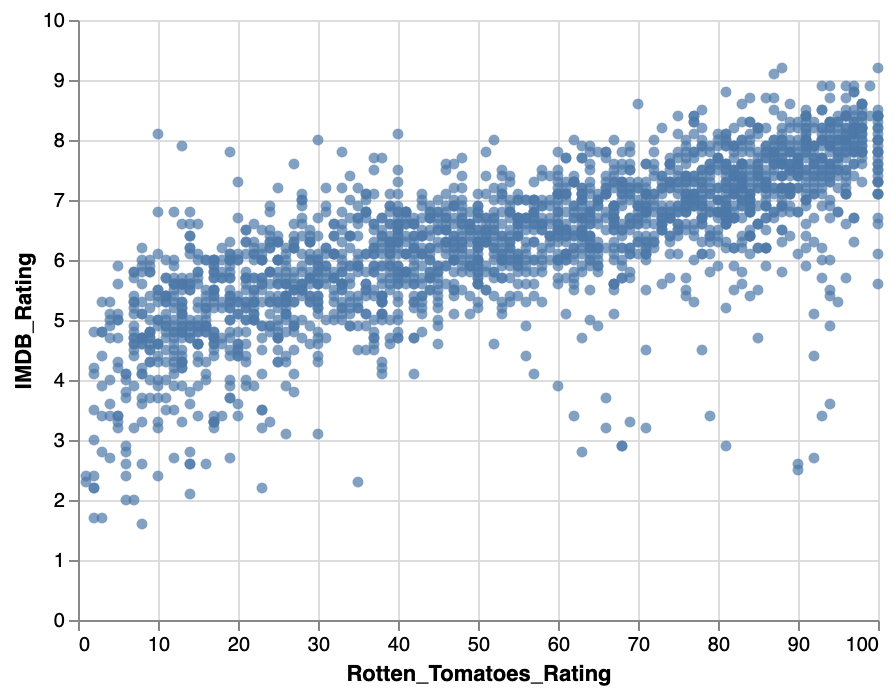
Your Turn (~5 min):
In the Lab 2 notebook, complete Step 1, from 1b to 1d. You should eventually end up with the following two histograms:
Rotten Tomatoes Counts per Rating (Binned)
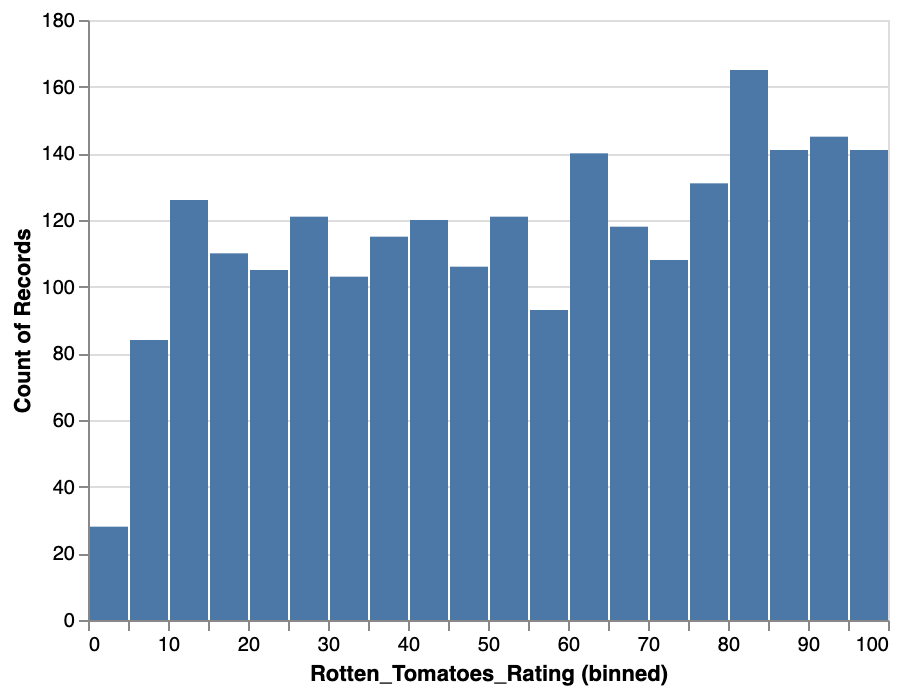
IMDb Counts per Rating (Binned)
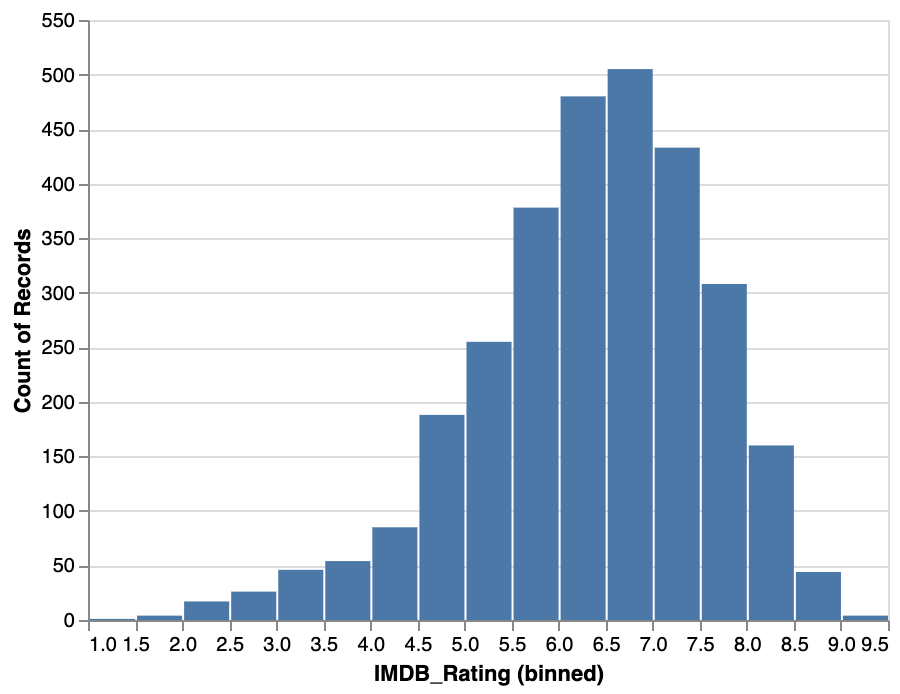
Common Problem: Overplotting
Benefits of Bins
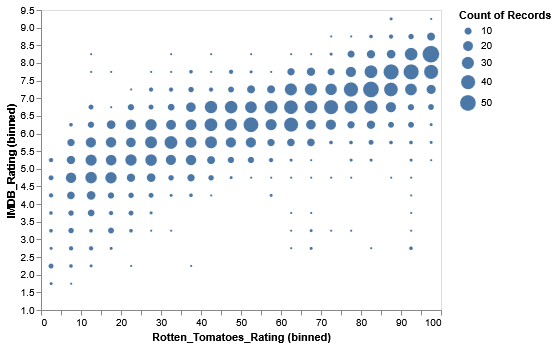
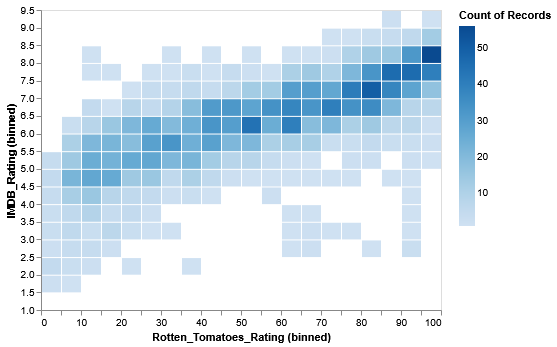
- Bins aren’t just restricted to histograms. They are compatible with other chart types
- Bins can alleviate overplotting issues.
- Bins can emphasize outliers in data distributions.
Step 2: Aggregation
Another data transformation that’s common is aggregation. We use aggregation to summarize groups of data (i.e. mean, median, min/max).
The Vega-Lite documentation includes the full set of available aggregation functions, which may be worth reading through.
Averages (Mean) Across Genres
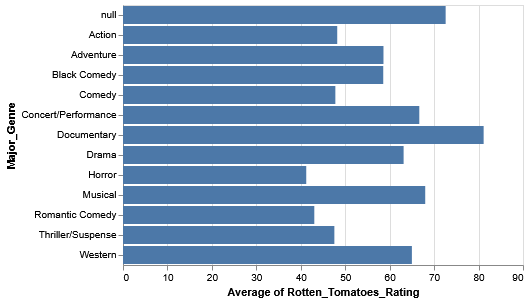
There may be some interesting variation, but it’s mentally tasking to try to understand overall rankings across genres.
Sorting
Rather than sort the genres alphabetically, let’s try to sort them in descending order of rating (i.e. the genres with the higher ratings are at the top, while the genres with the lower ratings are at the bottom).
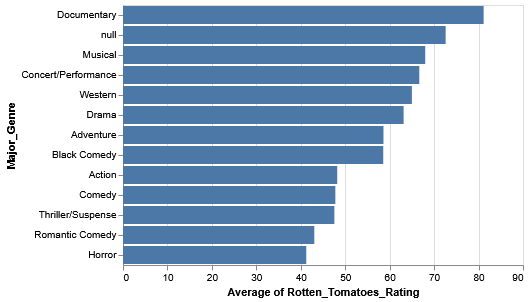
Food 4 Thought: Averages (Mean) vs. Median
Two Questions:
- What’s the difference between Averages (Mean) and Median?
- Why does it matter?
From Mean to Median
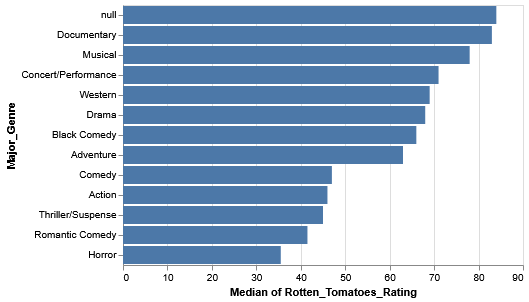
Even with this data, we should still be a bit skeptical. What if, within the genres themselves, there’s some skew caused by outliers and such? Observing the variation within each genre is a good way to extend our analysis.
Inter-Quartile Range (IQR)
Let’s add some nuance to our bar chart by considering the “Inter-Quartile Range (IQR)” of each genre.
The IQR is a special range across a set of values that represents where the middle half of the data resides in. A quartile represents 25% of data values. The IQR therefore represents the two middle quartiles, or the middle 50% of data.
Your Turn (~5 min):
In the Lab 2 notebook, complete Step 2d and 2e. You should eventually end up with the following two histograms:
IQR of Rotten Tomatoes Ratings, by Genres
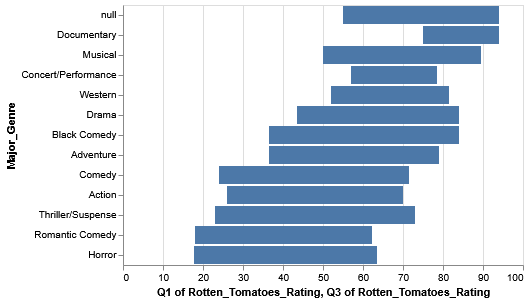
IQR of IMDb Ratings, by Genres
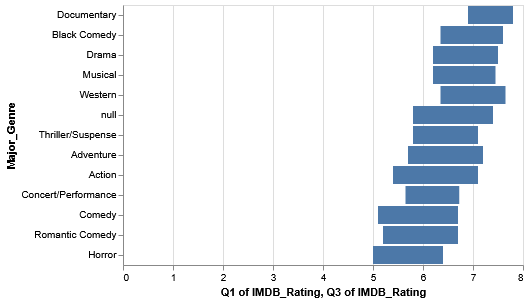
Core Concepts of Data Transformations
We Covered in the Lab:
Aggregation
- Purpose: Summarize groups of data
- Methods: Sum, mean, median, count, min, max
- Example: Daily sales → Monthly totals
Binning
- Purpose: Convert continuous to discrete
- Methods: Equal width, equal frequency, custom
- Example: Dividing age into groups (<18, 18-65, >65)
Covered in Assignment #2:
Filtering
- Purpose: Focus on relevant subset
- Types: Range, categorical, conditional
Normalization
- Purpose: Enable fair comparison
- Methods: Min-max, z-score, percentages
End of Lab
- Assignment #2 will be posted no later than September 13, 2025.
- Assignment #2 is due on September 18th, 2025 @ 11:59pm!
- Where do I ask questions?
- TA Office Hours:
- Physical Location: Wednesdays @ 2PM-3PM, 8th floor common area @ 370 Jay Street, Brooklyn
- Online Zoom: (https://nyu.zoom.us/j/92815268504)
- Our course Discord!
- TA Office Hours:

